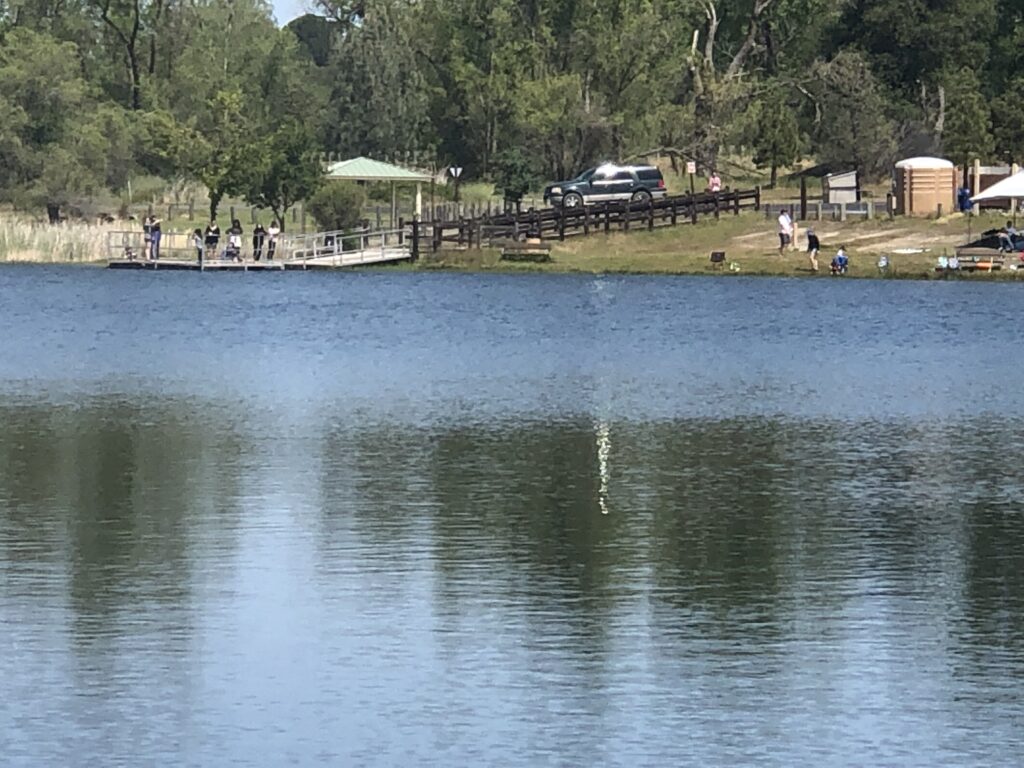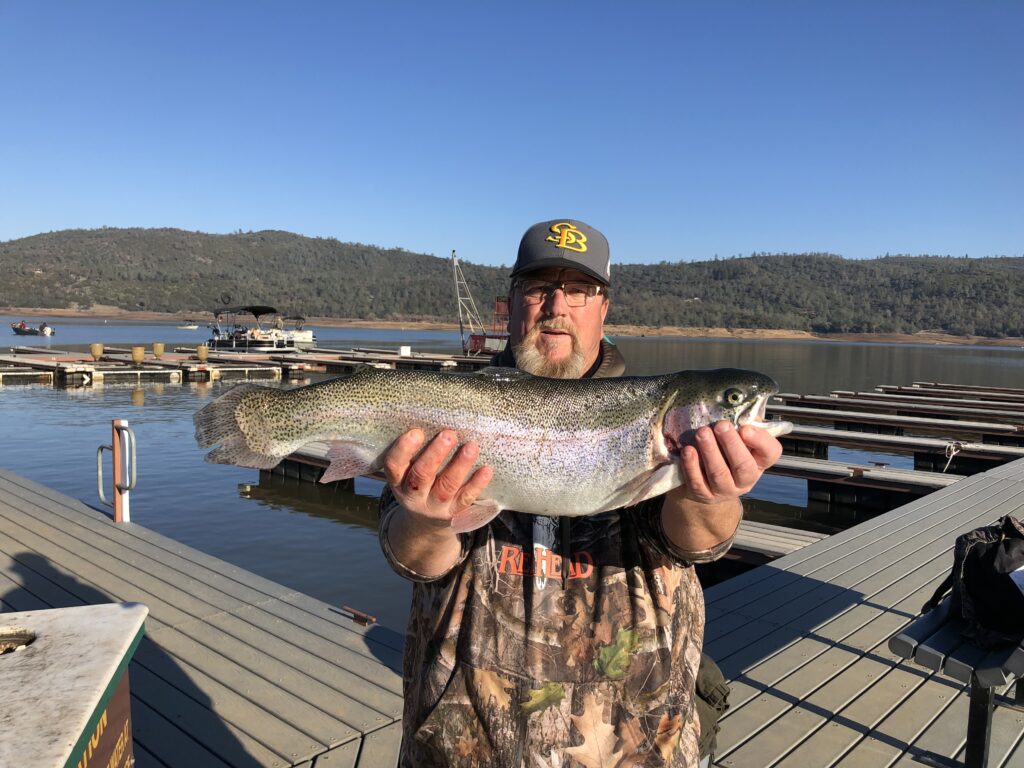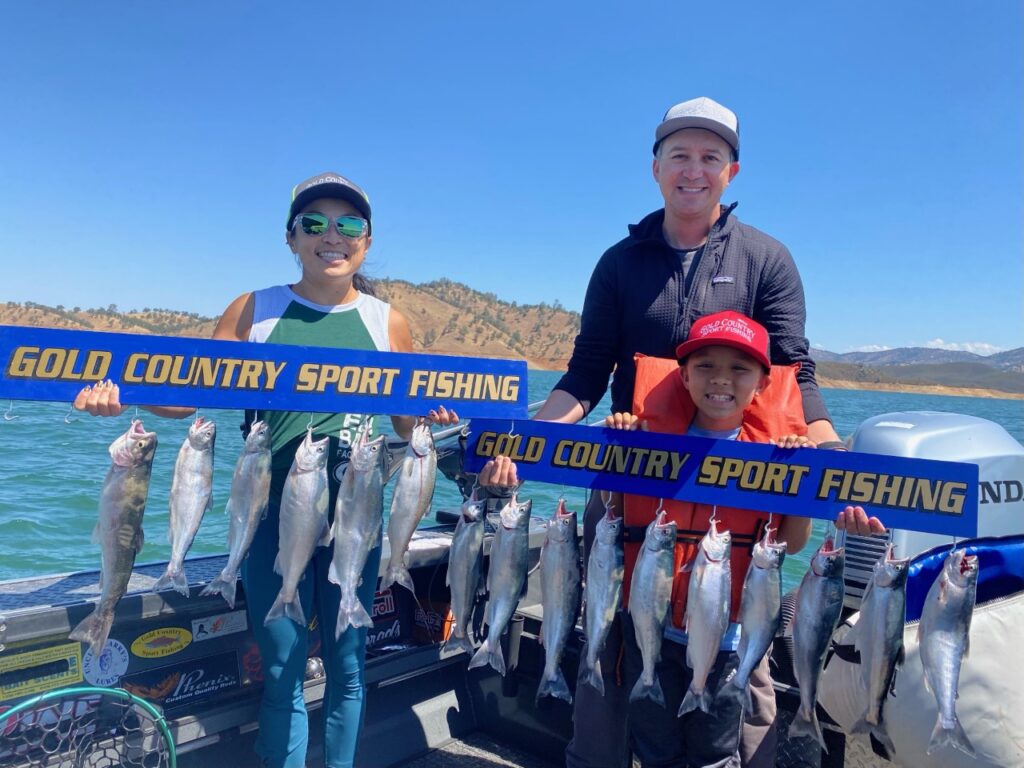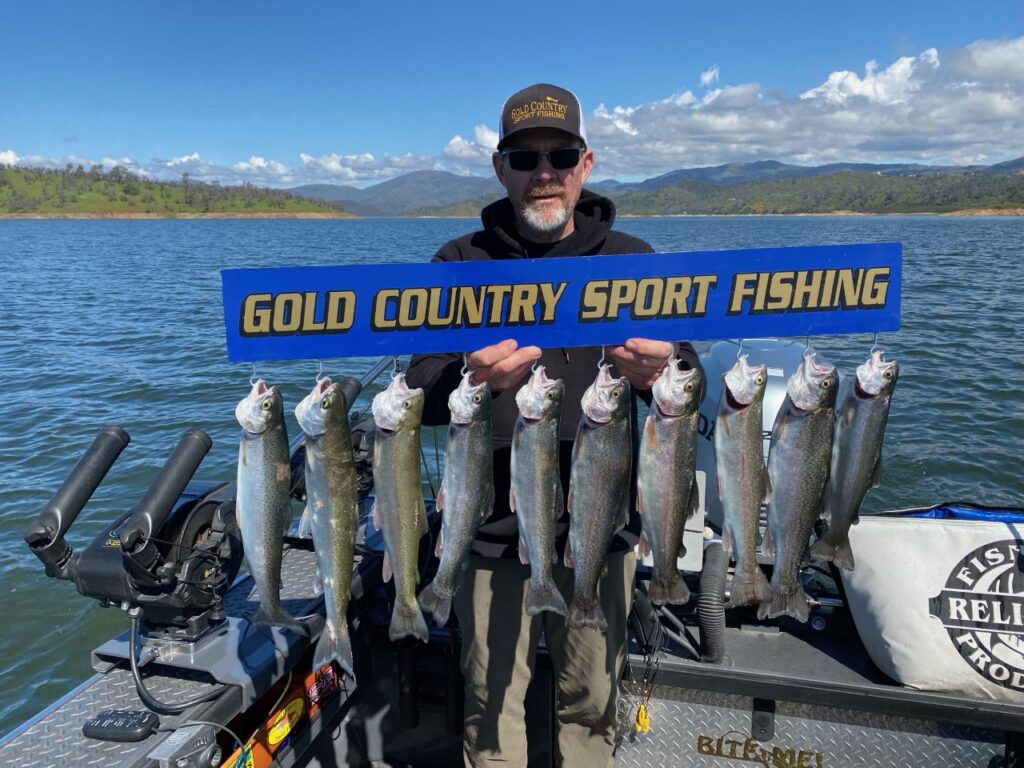Countdown To Trout Opener: Five Foothill Lakes Worth The Trip
With the statewide general trout opener set for this Saturday, April 29, we have a series of stories in our April issue previewing the big day. Today: Don’t want to head to the Sierra just yet? Try these Sierra foothills options.

A drought-busting wild and wet winter may make some high-elevation Sierra lakes inaccessible longer than usual, so in the meanwhile head to the foothills for some outstanding trout action. Lake Amador is noted
for producing huge rainbows and cutbows. This trophy was landed during a March trolling adventure. (LAKE AMADOR RECREATION AREA)
By Cal Kellogg
As I sit here hammering on the keyboard, the sky is gunmetal gray, wind is gusting hard and rain is spattering against my office window. As far as I’m concerned, this is a change for the better, since two weeks ago my driveway was buried under 4 feet of snow!
After a stubborn three-year drought, California has finally been the recipient of a rip-roaring winter. Our rivers are running chocolate- milk brown, reservoirs are being managed to prevent valley flooding, parts of the Delta are closed to boating to protect against levee erosion and the high country is blanketed with a snowpack exceeding 20 feet deep in many locations.
So, what does all this snow and rain mean for trout anglers this spring and summer? Clearly, our lakes and reservoirs are going to be full, but early on a lot of higher- elevation marquee trout waters are going to be inaccessible due to snow and ice. This is a good problem to have. It means most of us will spend the spring months chasing trout and landlocked salmon at Sierra foothill lakes, and then as spring gives way to summer at lower elevations, we’ll follow spring conditions upslope into the high Sierra!
The northern and central Sierra foothills are dotted with a long list of trout lakes, so let’s take a closer look at a handful of foothill destinations that are sure to offer top-notch fishing this April, May and June.

COLLINS LAKE
Collins Lake is at full capacity and spilling for the first time since 2017, and the lake is absolutely packed with trout. Aggressive trout planting kicked off last November and is slated to continue right on into May.
Due to the stellar efforts of the Collins Lake Recreation Area, around 40,000 pounds of rainbow and lightning trout are going to find their way into this Yuba County impoundment.
Most of these trout are chunky battlers weighing 2 to 3 pounds, but there are also big numbers of trophy fish in the 6- to 12-pound class lurking in Collins Lake’s rich waters.
Harsh weather kept a lot of anglers off the lake this winter. Those who did venture out were confronted with exceptionally cold, muddy water. As a result, most of the trout planted this winter have not been caught. Instead, they sat out the winter in deep water where they remained largely inactive.
It wasn’t until mid-March that some of the trout started stirring to life. Once the water temperature climbs into the upper 50s and lower 60s, look out, as Collins Lake’s trout population is going to go on the feed en masse and the fishing is going to be nothing short of epic.
I’ve been fishing Collins for nearly 30 years (California Sportsman, February 2023). Based on what I’ve been seeing, I think we may be on the verge of the best spring trout season on record at Collins!
If you pay Collins Lake a visit this April or May, what is the best way to get your trout on? If you are a bank angler, PowerBait is the not-so-secret ingredient for success. All the colors of the rainbow will work, but nothing produces results as consistently as green garlic-flavored dough.
Boaters can score trolling a variety of offerings. Traditionally, small Rapalas and chrome/blue Kastmasters perform well.
I’ve had exceptional luck on Trout Trix Worms, threaded nightcrawlers and plastic grubs. For trophy rainbows, say, fish in the 8- to 12-pound class, trolling flies are my hands-down choice.
Collins Lake, with its 1,200 surface acres, has become a favorite destination for kayak trout anglers over the past few years. Many of these trouters split their time between trolling and beaching their ’yaks to fish PowerBait along out-of-the-way stretches of shoreline that seldom play host to bank anglers.
In addition to fishing, the Collins Lake Recreation Area features camping, boat rentals, two boat ramps, laundry facilities, showers, gas, store and more! See collinslake.com.

This huge Collins Lake rainbow weighed just over 8 pounds. The big fish blitzed an orange trolling fly pulled 2 feet deep. The Yuba County reservoir offers some of Northern California’s best trout fishing. (CAL KELLOGG/CHRIS COCOLES)

LAKE AMADOR
Situated in Amador County, Lake Amador is a small but deep lake boasting 385 acres at maximum capacity.
If you’re looking for the absolute biggest planted trout in the foothills, Lake Amador is the place. A slew of massive trout have come out of Amador in recent years. In 2020, Juan Garcia popped a lake- record 20.1-pound cutbow. In the same year, Jeremy Silvas landed a 19.3-pound lake-record rainbow. In 2022, Stephen Blecha set a new lake record for lightning trout when he successfully landed a 13.04-pounder.
The management at Lake Amador operate their own trout hatchery, and the number of trout they put into the lake is incredible. In 2023, around 50,000 pounds of trout will be planted. Some of these fish are pan-sized fryers, but there are many 10-plus-pound monsters in the mix.
Between the big number of trout going into Amador and the lake’s small size, you’d think hooking up would be a pushover, but often the trout fishing is challenging. For whatever reason, Amador’s trout often play hard to get. Small offerings tend to outpace larger baits.
For bank anglers, PowerBait certainly works, but the all-time hands-down favorite bait at Amador is one or two white Berkley Power Eggs pinned on a hook. You can fish them off the bottom or suspend them under a slip bobber.
Another great option for bank anglers is tossing a No. 8 black Woolly Bugger streamer fly combined with a clear water-filled bobber. The weight of the bobber allows for long casts.
Once the rig splashes down, you can play with different retrieves until you figure out what the trout want on any given day.
When it comes to trolling, small Rapalas in blue/silver, black/silver or fire tiger are probably the No. 1 bait for producing trophy-size fish. A trolling fly, either by itself or combined with a half-inch section of nightcrawler, is a sleeper trophy bait.
For rank-and-file-sized trout
trollers pull 2- and 3-inch soft plastic grubs in a range of different colors, Speedy Shiners in the smallest size and Gulp! Crawlers rigged behind Turbo Flashers.
Amador is kayak-friendly due to its small size. Kayakers often score well in the Jackson Creek Arm by trolling lures or drifting with bait.
If you go to Amador, be sure to bring your patience. The trout can be fickle, but you’re one bite away from battling a rainbow or cutbow in the 20-pound class!
Lake Amador has a store, restaurant, boat launching facilities, camping sites and fishing dock. For more info, see lakeamador.com.

. A lot of the trout caught at Camanche Lake are pan size, but huge 10-plus-pound trophies like the big rainbow below are in the mix too. (BIG NATE’S GUIDE SERVICE)
CAMANCHE LAKE
The largest of the four Mother Lode lakes and straddling Amador, San Joaquin and Calaveras Counties, Camanche Reservoir impounds the waters of the Mokelumne River and its tributaries. Camanche is a large body of water with 7,700 surface acres when at full capacity. This makes it approximately six times the size of Collins Lake, and it has coves larger than Lake Amador.
Camanche has an extensive main body and a river arm featuring several large bays. At times the wind rips at Camanche and the waters in the river arm provide shelter for small boaters and anyone who doesn’t enjoy being bounced around.
Sixty thousand pounds of trout are annually stocked in the lake between November and May. Camanche has the reputation for booting out lots of pan-sized rainbows, but there are enough trout weighing 6 to 10 pounds to keep things interesting.
While Camanche holds big numbers of trout, tracking them down is the trick, due to the reservoir’s large size. Bank anglers have a lot of available territory to explore on both the north and south sides of the lake. Trout are planted at the North Shore and South Shore launch ramps, and the fish spread out from there.

Bank anglers at Camanche should have a two-rod sticker. You’ll want to soak PowerBait on one rod and fan cast with the other. In terms of lures, small Countdown Rapalas and 1?4-ounce Kastmasters are great choices. Shad are the primary forage at the lake, so choose lure colors accordingly.
My rule of thumb when bank fishing Camanche is to stay on the move until I find productive water. I typically give each spot 20 to 30 minutes to produce. If no bites occur in that time frame, I make a move.
Trollers do well at Camanche pulling shad-imitating lures. Local favorites include Speedy Shiners, Trigger Spoons and Rapalas pulled from 2.5 to 3.5 mph. If the fast stuff isn’t working, 3-inch soft plastic grubs tend to work well when trolled from 1.5 to 2 mph.
A lot of kayakers are intimidated by Camanche’s large size, but I’ve had great luck fishing the reservoir from my Hobie. I typically launch off the South Shore ramp and turn right, heading up into the river arm.
to work tight to shoreline structure and into small coves. This gives me access to plenty of water that large aluminum trout sleds have a tough time trolling.
See golakecamanche.com for more.

apt. Monte Smith shows off a pair of limits of hard-fighting Don Pedro Reservoir ’bows his clients landed during a trolling trip this March. (GOLD COUNTRY SPORTFISHING)
DON PEDRO RESERVOIR
Don Pedro, formed on the Tuolumne River watershed, is the sixth largest reservoir in California, with 13,000 surface acres when full. In my opinion, it is also one of the most overlooked lakes by California’s trout and landlocked salmon anglers. You’ll often hear trollers talk about Shasta or Berryessa, but seldom do you hear anyone singing the praises of Don Pedro. I’ve never been sure why this is the case.
First and foremost, Don Pedro is an absolute rainbow factory. The lake is planted with rainbows annually, but the reservoir also has a massive self- sustaining population of holdover and wild rainbows spawned in the Tuolumne River.
How good is the rainbow action?
I’ve fished kokanee tournaments at Don Pedro and have had to leave certain areas of the lake simply because I couldn’t keep the rainbows off my gear long enough to hook a kokanee!
In addition to the rainbows, there is a sleeper brown trout population at Don Pedro. The lake also boasts king salmon ranging up to and beyond 10 pounds and kokanee ranging from 12 to 16 inches, depending on the year.
It’s not uncommon when trolling the reservoir to pull off a “Don Pedro hat trick” of catching rainbows, kings and kokanee all in one day.
Threadfin shad fuel the rainbow and king salmon fishing at Don Pedro. During the midsummer, rolling shad in deep water on a downrigger is often the most productive option, but during the spring and early summer power trolling shad imitations from the surface to 25 feet deep at 2.5 to 3.5 mph generally works well for both rainbows and kings.
Top lures for this work include Speedy Shiners, Rapalas, Yo-Zuri L Minnows and Speed Spoons in finishes resembling shad. If you happen to hit the lake on a day when the trout are fickle, a threaded ’crawler behind a small dodger or Turbo flasher trolled at 1.8 mph is often money in the bank.
Shore anglers can score at Don Pedro slinging PowerBait, but to really get into the holdovers nothing works as well as a 2- to 3-inch live minnow drifted 6 to 10 feet deep beneath a slip bobber.
Don Pedro features a good-sized main body and an extensive river arm. Kayakers can absolutely score at the lake, but a powerboat is the way to go to really explore.
For more, see donpedrolake.com.

Your favorite high Sierra lake could be inaccessible early this spring after a barrage of winter snow. But don’t fret. “It means most of us will spend the spring months chasing trout and landlocked salmon at Sierra foothill lakes,” writes author Cal Kellogg, who caught this dandy Don Pedro rainbow while toplining an orange Metal Head Trolling Fly during a spring outing. (CAL KELLOGG)
NEW MELONES RESERVOIR
Calaveras and Tuolumne Counties share New Melones Reservoir. Formed on the Stanislaus River, New Melones is about 25 percent smaller than Don Pedro.
While the reservoir offers very good rainbow trout fishing and boots out the occasional monster brown trout, I’m not giving New Melones honorable mention here due to the trout fishing it offers. Instead, I want to highlight the excellent kokanee fishing at the reservoir, which kicks off in May and extends well into the summer.
Of course, several California reservoirs feature kokanee, but for the past couple seasons New Melones has had the distinction of producing some of the biggest kokanee in the state. These landlocked sockeye salmon running 14 to 16 inches should be the rule this season, with fish in the 18- to 19-inch class, or perhaps bigger, likely available this summer.
To catch a limit of tasty kokes, work the lake’s main body and play with standard corn-tipped kokanee offerings such as snelled spinners and hoochies teamed with dodgers until you figure out what tickles the fancy of these diminutive fish on any given day.
I’ve scored a lot of handsome New Melones kokanee on pink offerings, but orange- and green-colored lures have worked well for me too. CS



